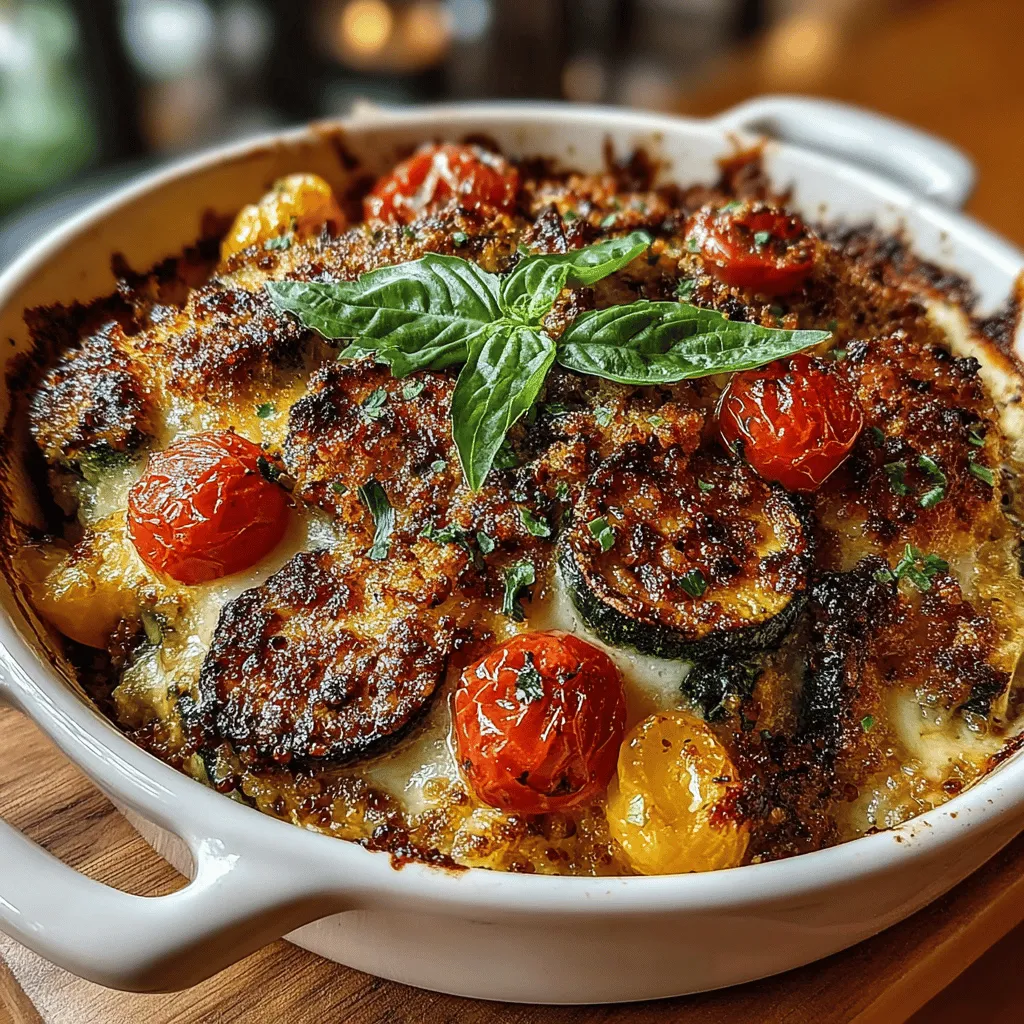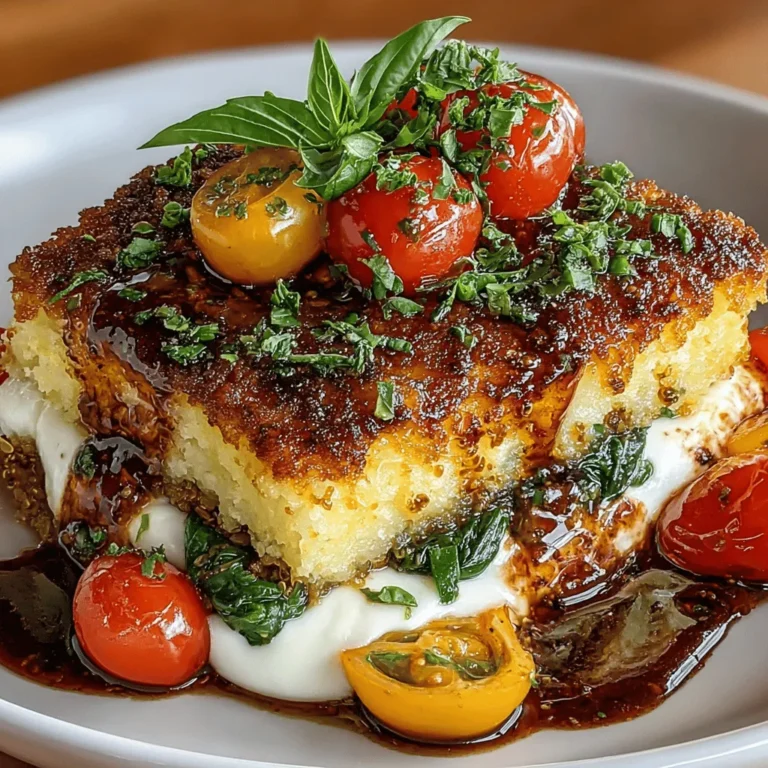Cheesy Balsamic Casserole: A Flavorful Journey
The world of casseroles is vibrant and versatile, filled with endless possibilities for flavor and nutrition. One standout recipe that combines the heartiness of grains, the freshness of vegetables, and the creaminess of cheese is the Cheesy Balsamic Casserole. This dish is perfect for those seeking a nutritious meal that is easy to prepare, packed with flavor, and sure to impress at any gathering. In this article, we will explore the ingredients, preparation steps, nutritional benefits, variations, and serving suggestions for this delightful casserole.
Understanding the Cheesy Balsamic Casserole
Casseroles are a beloved comfort food, often associated with family gatherings and potlucks. They allow for creativity in the kitchen, combining various ingredients to create a satisfying dish. The Cheesy Balsamic Casserole is no exception, bringing together the nutty flavor of quinoa, the robustness of vegetables, and the richness of cheese, all harmonized by the tangy notes of balsamic vinegar.
At its core, this casserole is a celebration of textures and flavors. The nutty quinoa base provides a healthy foundation, while the sautéed vegetables add a vibrant crunch. The melted mozzarella and ricotta cheeses introduce a creamy richness, creating a perfect balance with the balsamic vinegar’s slightly sweet and tangy profile. This dish is not only a feast for the palate but also a visual delight, making it an ideal centerpiece for any meal.
Ingredient Breakdown
To create the Cheesy Balsamic Casserole, you will need a selection of wholesome ingredients that contribute to both its flavor and nutritional value. Here’s a closer look at the key components of this recipe:
– Quinoa: This protein-rich grain serves as the base of the casserole. Known for its complete protein profile, quinoa is a fantastic alternative to traditional rice or pasta, making the dish more nutritious and filling.
– Eggplant: This versatile vegetable adds a unique texture and absorbs flavors beautifully, enhancing the overall taste of the casserole.
– Bell Pepper and Zucchini: These vegetables provide color, crunch, and essential vitamins, adding both visual appeal and nutritional benefits.
– Cherry Tomatoes: Offering a burst of sweetness and acidity, cherry tomatoes elevate the dish, balancing the rich flavors of cheese and balsamic vinegar.
– Fresh Spinach: Rich in iron and vitamins, spinach enhances the nutritional profile of the casserole while adding a lovely green hue.
– Mozzarella and Ricotta Cheese: These cheeses contribute creaminess and depth of flavor. Mozzarella melts beautifully, while ricotta adds a luxurious texture.
– Balsamic Vinegar: This ingredient elevates the dish with its sweet and tangy flavor, creating a harmonious blend with the other ingredients.
– Olive Oil and Garlic: Essential for sautéing and flavor enhancement, these ingredients form the aromatic base of the casserole.
– Dried Oregano: Adding an aromatic touch, dried oregano ties the ingredients together, complementing the flavors of the vegetables and cheese.
Preparation Steps
Creating the Cheesy Balsamic Casserole is a straightforward process that requires some preparation and attention to detail. Here’s a step-by-step guide to help you through the initial stages of crafting this delectable dish:
1. Preheating the Oven
Before you begin assembling your casserole, it’s crucial to preheat your oven. Setting the temperature to 375°F (190°C) ensures that the casserole cooks evenly and allows the cheese to melt to perfection. Preheating your oven not only saves time but also helps achieve the ideal texture for your dish.
2. Sautéing the Vegetables
While the oven is warming up, you can start preparing your vegetables. Heat a generous amount of olive oil in a large skillet over medium heat. Add minced garlic and sauté for about 30 seconds until fragrant. Then, introduce diced eggplant, bell pepper, and zucchini to the skillet.
Sauté these vegetables until they soften, which should take about 5-7 minutes. The goal is to achieve a tender texture while still retaining some crunch. This method enhances the flavors and allows the vegetables to caramelize slightly, adding depth to the casserole.
3. Mixing the Quinoa
In a separate pot, cook your quinoa according to package instructions. Typically, you’ll need to rinse the quinoa under cold water, then combine it with water or vegetable broth in a saucepan. Bring it to a boil, reduce the heat, and let it simmer until the grains are fluffy and the liquid is absorbed.
Once the quinoa is ready, incorporate it into the sautéed vegetable mixture. Stir well to ensure an even distribution of flavors and ingredients. This step is vital as it allows the quinoa to absorb the flavors from the vegetables and garlic, creating a cohesive base for your casserole.
4. Preparing the Cheese Mixture
In a mixing bowl, combine the ricotta cheese and shredded mozzarella. For the best results, consider adding a pinch of salt and freshly ground black pepper to enhance the flavors. Mixing these cheeses together will create a smooth and creamy consistency that will beautifully complement the other ingredients in the casserole.
Once the cheeses are combined, fold in the fresh spinach and cherry tomatoes. The warmth from the quinoa and vegetables will slightly wilt the spinach, allowing it to blend harmoniously with the cheese. This mixture will provide a rich, creamy layer that contrasts perfectly with the other components of the dish.
By following these steps, you are well on your way to assembling a delicious and nutritious Cheesy Balsamic Casserole that will delight your family and friends. Keep an eye out for the next part of this article, where we will delve deeper into the final assembly process, baking instructions, and tips for serving this delightful dish.

Assembling the Casserole
To create a Cheesy Balsamic Casserole that is not only delicious but also visually appealing, it’s essential to master the art of layering. The layering technique plays a crucial role in ensuring that every bite is packed with flavor while maintaining an attractive presentation.
Layering Techniques for Optimal Flavor and Presentation
1. Start with a Base Layer: Begin by spreading a thin layer of the cooked quinoa on the bottom of your casserole dish. This forms a sturdy base that will absorb flavors from the other ingredients and prevent the casserole from becoming too watery.
2. Add Vegetables: Next, layer your roasted vegetables evenly over the quinoa. Be sure to include a mix of colors and textures—zucchini, eggplant, bell peppers, and spinach work beautifully together. This not only enhances the flavor but also makes the dish more visually appealing.
3. Cheese Layer: Sprinkle a generous amount of cheese over the vegetables. Opt for a combination of shredded mozzarella and parmesan for a perfect blend of creaminess and flavor depth. The cheese will melt beautifully, binding the layers together.
4. Repeat Layers: Continue this layering process—quinoa, vegetables, and cheese—until you reach the top of the casserole dish. Finish with a final layer of cheese to create a golden, bubbly crust.
5. Balsamic Drizzle: Before placing the casserole in the oven, drizzle some balsamic vinegar over the top. This will not only infuse the dish with its distinct flavor but also create a beautiful glaze during baking.
Baking the Casserole
Understanding the baking process is crucial for achieving the best results with your Cheesy Balsamic Casserole. The right temperature and timing will ensure that the dish is cooked evenly and that the flavors meld perfectly.
Baking Process for Best Results
1. Preheat the Oven: Preheat your oven to 375°F (190°C). A properly heated oven is essential for even cooking and browning.
2. Cover the Casserole: Initially, cover the casserole with aluminum foil. This prevents the top from over-browning while the inside cooks through. Bake for about 25-30 minutes covered.
3. Uncover and Brown: After the initial baking time, carefully remove the foil and continue baking for another 15-20 minutes. This step allows the cheese to melt and develop a golden-brown crust, enhancing both texture and flavor.
4. Check for Doneness: Ensure that the casserole is heated through and the vegetables are tender. A knife inserted into the center should come out clean, signaling that the dish is ready.
5. Cooling Time: Once out of the oven, let the casserole cool for about 10 minutes. This resting period allows the layers to set, making it easier to slice and serve.
Garnishing and Serving
Presentation is a vital aspect of any dish, and garnishing your Cheesy Balsamic Casserole can elevate its appeal significantly.
Enhancing Visual Appeal with Fresh Basil
1. Add Fresh Herbs: Once the casserole has cooled slightly, sprinkle freshly chopped basil on top. The bright green color and aromatic scent of basil add a refreshing contrast to the rich flavors of the cheese and balsamic.
2. Serve Warm: Cut the casserole into squares and serve warm. This dish pairs wonderfully with a side salad or crusty bread, making for a complete and satisfying meal.
Nutritional Benefits
The Cheesy Balsamic Casserole is not only delicious but also packed with nutritional benefits, making it a healthy choice for a variety of dietary needs.
Highlighting the Health Advantages of the Ingredients
– Quinoa: This ancient grain is a complete protein source, containing all nine essential amino acids. It is also rich in fiber, which aids digestion and promotes satiety.
– Vegetables: The colorful array of vegetables used in this casserole is packed with vitamins, minerals, and antioxidants. These nutrients support overall health and can help reduce the risk of chronic diseases.
– Cheese: Cheese is an excellent source of calcium and protein, both of which are essential for maintaining strong bones and overall health. When used in moderation, cheese can be part of a balanced diet.
– Balsamic Vinegar: Besides its tangy flavor, balsamic vinegar contains antioxidants and may aid in digestion. It can also help balance blood sugar levels, making it a beneficial addition to your meal.
– Overall Nutritional Profile: The combination of quinoa, vegetables, and cheese in this casserole creates a balanced dish that supports various dietary needs. This meal is a great option for vegetarians and those looking to incorporate more plant-based ingredients into their diet.
Variations and Substitutions
One of the best aspects of a casserole is its versatility. Here are some creative twists and substitutions to personalize your Cheesy Balsamic Casserole:
Creative Twists to Personalize the Casserole
– Protein Additions: To make the casserole heartier, consider adding cooked chicken, turkey, or plant-based proteins like chickpeas or lentils. These additions can enhance the protein content and make the dish more filling.
– Vegetable Swaps: Feel free to mix and match vegetables based on seasonal availability or personal preference. Cauliflower, broccoli, or even sweet potatoes can be excellent alternatives that bring their unique flavors and textures.
– Cheese Choices: Experiment with different types of cheese to create varied flavor profiles. Goat cheese or feta can add a tangy twist, while cheddar can bring a sharper flavor.
– Vegan Options: For a plant-based adaptation, replace regular cheese with vegan cheese alternatives made from nuts or soy. You can also substitute eggs with flaxseed meal mixed with water to bind the ingredients together.
Serving Suggestions
Enhancing your dining experience goes beyond just the casserole itself. Here are some ideas for pairing and presentation:
Ideas for Pairing and Presentation
– Complementary Side Dishes: The Cheesy Balsamic Casserole pairs beautifully with fresh salads, such as a simple arugula salad tossed with olive oil and lemon juice, or a Mediterranean grain salad. Crusty bread or garlic bread also makes a fantastic accompaniment.
– Presentation Tips: Serve the casserole in a vibrant dish to accentuate its colors. Consider using a rustic ceramic or a glass baking dish that can go directly from the oven to the table. A sprinkle of freshly chopped basil and a drizzle of balsamic reduction before serving can enhance visual appeal.
– Ideal Occasions: This casserole is perfect for a range of occasions—from casual weeknight dinners to festive gatherings. It is a crowd-pleaser and can be easily scaled up for larger groups, making it an ideal choice for potlucks or family celebrations.
Conclusion
The Cheesy Balsamic Casserole is not just a meal; it’s an experience that brings together wholesome ingredients and flavors in a comforting dish. Whether you’re enjoying it as a weeknight dinner or serving it at a special occasion, this casserole is sure to delight and nourish. With its myriad of nutritional benefits, diverse variations, and satisfying taste, it’s a recipe that deserves a place in your culinary repertoire. Embrace the joy of cooking and savor the deliciousness that this casserole brings to the table.
With its rich flavors and customizable nature, the Cheesy Balsamic Casserole invites you to explore your creativity in the kitchen while enjoying a dish that is as nutritious as it is delicious. So gather your ingredients, get ready to layer, and enjoy this delightful casserole with your loved ones!


